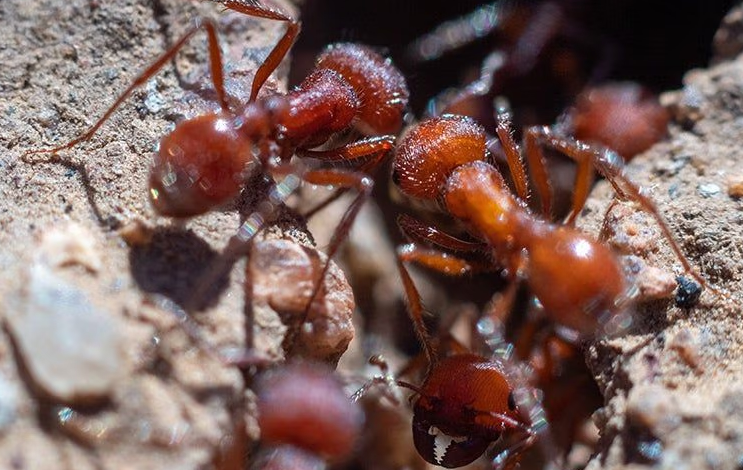
Harvester Ant Identification & Prevention In Nassau & Suffolk County, NY
What do harvester ants look like?
Latin name: Pogonomyrmex spp.
The Western harvester ant is found in the west at high elevations. This is a red colored ant that can be 6.5 to 10 mm long. Galleries have been found to go over 600 cm deep.
How did I get harvester ants?
Flat, open and sparsely shaded lawns give harvester ants room to build their mounds, plus these ants generally prefer to build their nests in sandy soil. Since seeds are a major part of the harvester ant diet, gardens or bird feeders may also attract these insects. Harvester ants tend to avoid indoor areas, but sometimes enter homes by accident through cracks and gaps around windows or doors. Harvester ants are very large and robust.

How serious are harvester ants?
Harvester ants are an outdoor nuisance, especially in backyards or recreational areas. Many species of these pests can deliver painful stings and bites, but are not considered as aggressive as fire ants. However, a harvester ant sting can last longer than the stings of other stinging ants, and allergic reactions can be serious. Their mounds cause unsightly barren spots in lawns and landscaping.
How can you get rid of harvester ants?
All State Pest Control is trained to help manage Harvester Ants and similar pests. Since every building or home is different, your All State Pest Control technician will design a unique program for your situation.
Keeping ants out of homes and buildings is an ongoing process, not a one-time treatment. All State Pest Control’s exclusive A.I.M. solution is a continuing cycle of three critical steps — Assess, Implement and Monitor.
All State Pest Control can provide the right ant control solution to keep ants in their place…out of your home, or business.
What are the signs of a harvester ant infestation?
Aside from the ants themselves, the large mounds, almost 53 inches across in some cases, and denuded vegetation near to the nest are the most visible signs of harvester ant activity.

Reasons to Choose All State Pest Control
-
Hablamos EspañolPest control services provided by a Spanish-speaking team.
-
Emergency Services AvailableGet the immediate help you need, whenever you need it.
-
100% Satisfaction GuaranteeWe're so confident you'll be happy with our services, we guarantee it.
-
Offering 100% Free QuotesGet started by giving us a call and setting up a free estimate.
What are the behavior, diet, and habits of harvester ants?
The three common species of harvester ants — the red, western and California harvester ants — each have unique behaviors, castes and tasks, feeding, nesting patterns and defense mechanisms. The harvester ant behavior differs between each species, seen through their feeding and nesting habits. In addition, unlike many other ants that infest indoor structures, all species of harvester ants prefer not to invade houses and buildings, but will establish their nests around gardens or yards, often destroying vegetation.
The red harvester ants can be aggressive. They deliver a painful sting. Sometimes, the stings of harvester ants can cause allergic reactions, especially to those sensitive to their venom. Aside from their powerful stings, harvester ants also bite viciously.
This is an important agricultural pest in many areas. The feeding habits of red harvester ants can be seen as they leave their nests and travel to their food sources, leaving a distinct scent throughout their paths.

Hear From Our Happy Customers
At All State Pest Control, your satisfaction is our priority! See for yourself what people have to say about working with us.
-
“I highly recommend this business as they are very professional and reasonably priced.”- Stray C.
-
“The job was very thorough, very reasonably priced and Tom was very professional.”- Patrick M.
-
“So happy we used this company and will be using them again! Great work great owner and great service.”- Stefani J.
-
“For bringing them so much work they occasionally offer us free treatments and that is just good business!”- Derek B.
Are harvester ants poisonous?
The answer to this question is YES, harvester ants are poisonous. In general, the harvester ants in the genus Pogonomyrmex are aggressive biters that inject potent and painful venom with their stingers. Like most stinging insects, their level of aggression and venom potency differs between species within the genus. For example, the Florida harvester ant, Pogonomyrmex badius, is not considered an aggressive ant, but its venomous sting is very painful.
What is the reproduction and life cycle of harvester ants?
Colonies usually contain a single queen who is responsible for producing the eggs. Winged reproductives, also called swarmer or alates, are produced in the summer. Males die soon after mating with the females, who go on to found new colonies.



